Click to expand:
- Crown and Bridge Prosthetics
- Orthodontia
- Scaling and Root Planing
- Teeth Whitening
- Implants
- Bone Grafting
- Laser Dentistry
- Botox
- Fillings
- CBCT Scan
- Oral Sedation (Halcion)
- Extractions
- Root Canals
- Occlusal Guards
Crown and Bridge Consent Form:

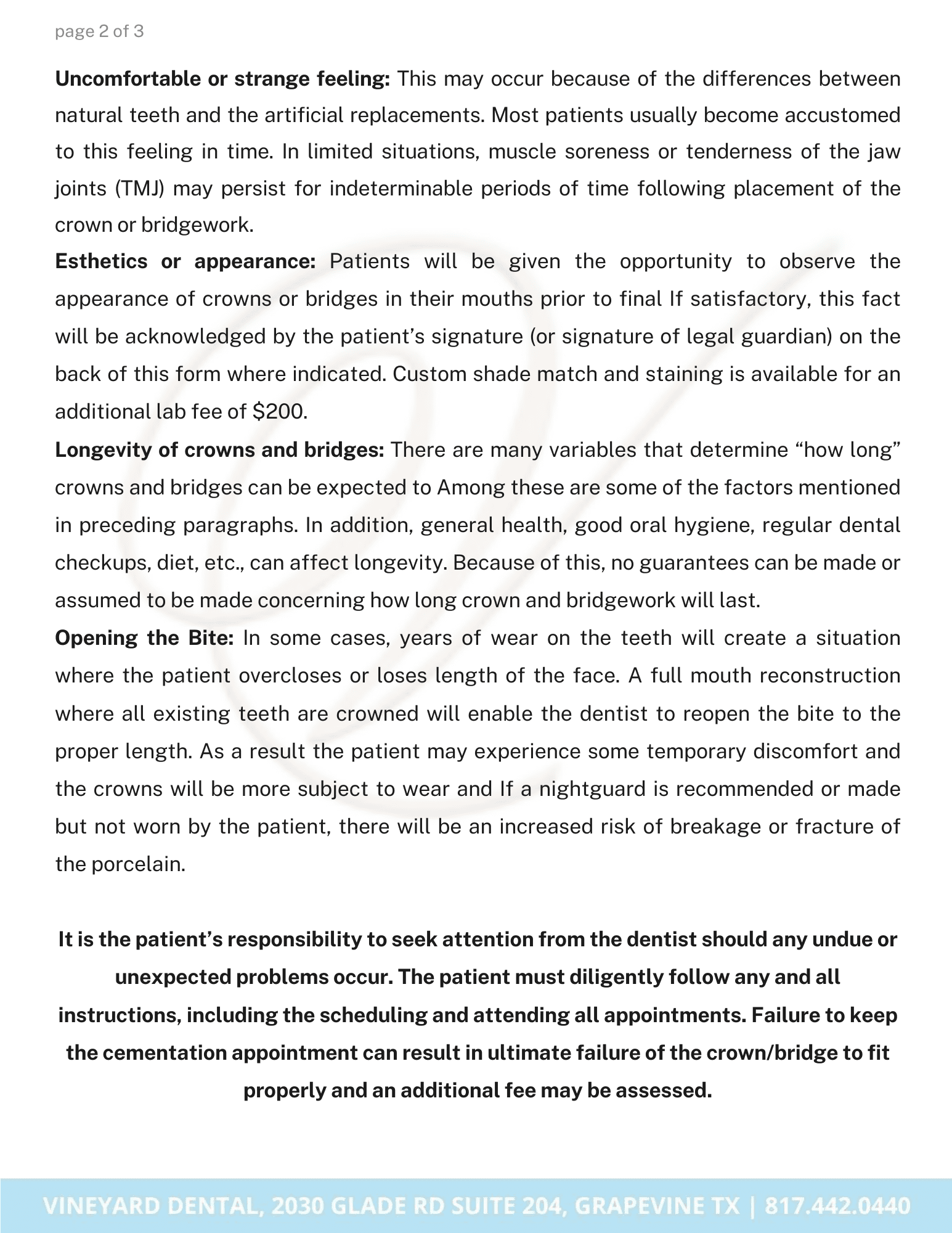
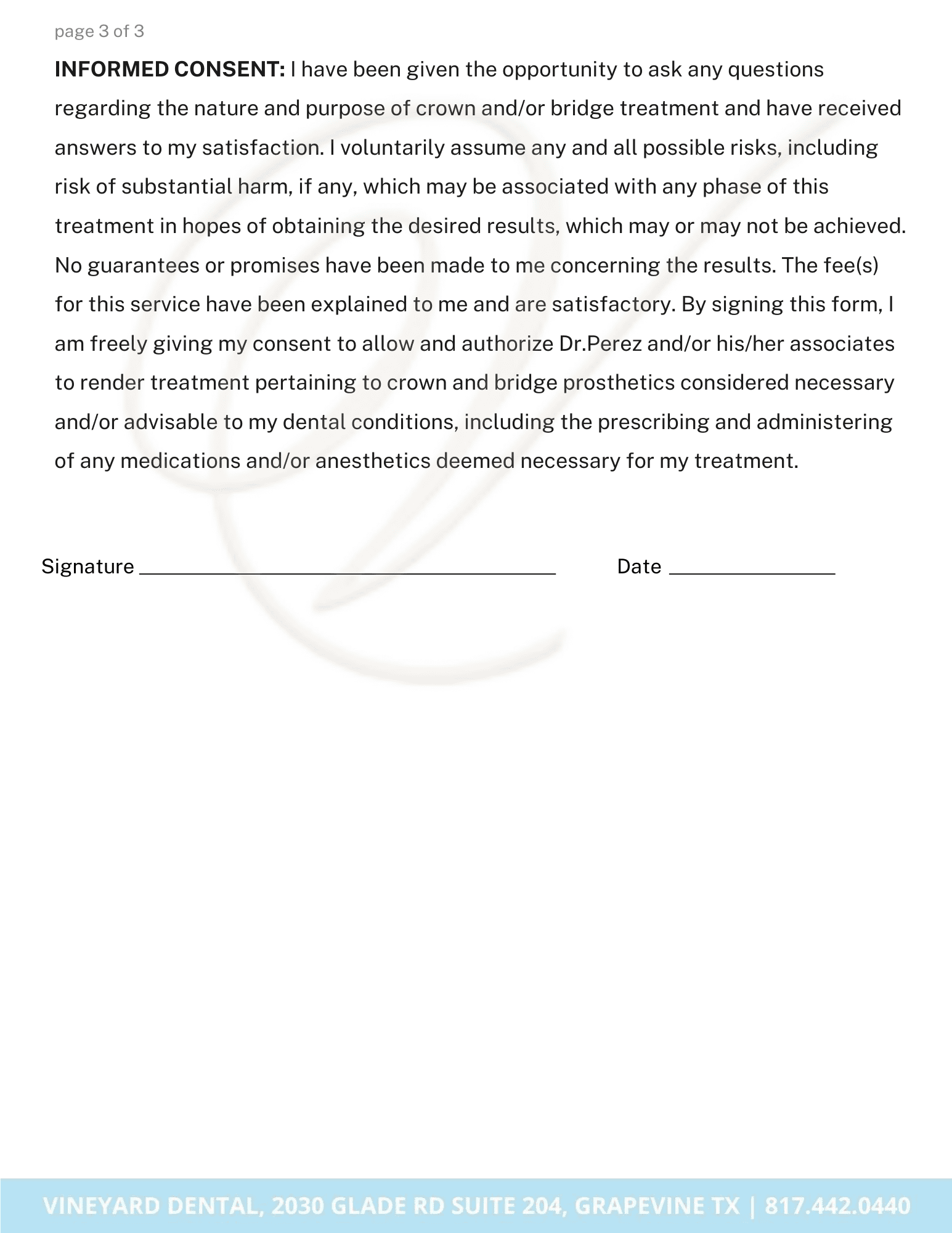
Orthidontia Consent Form:
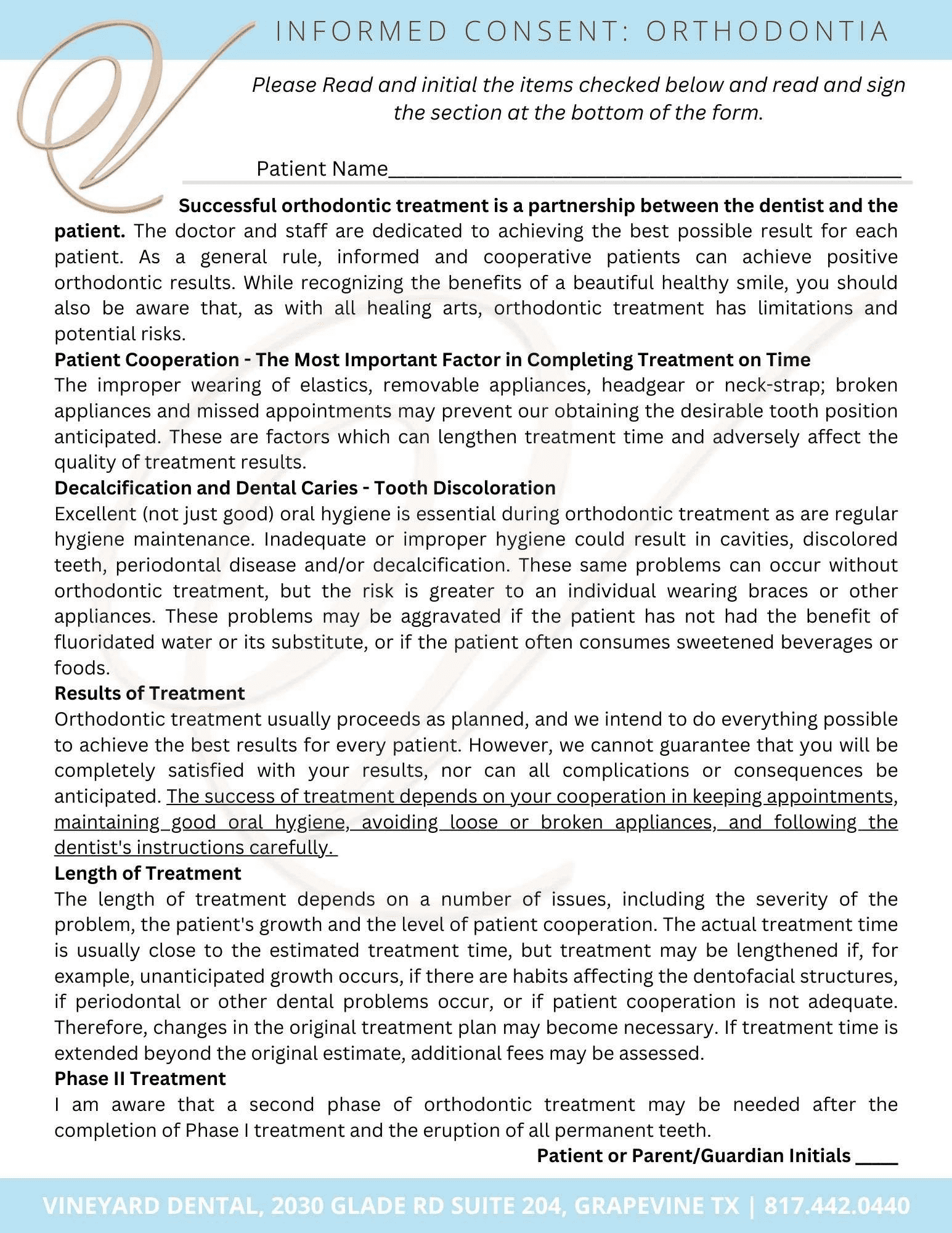
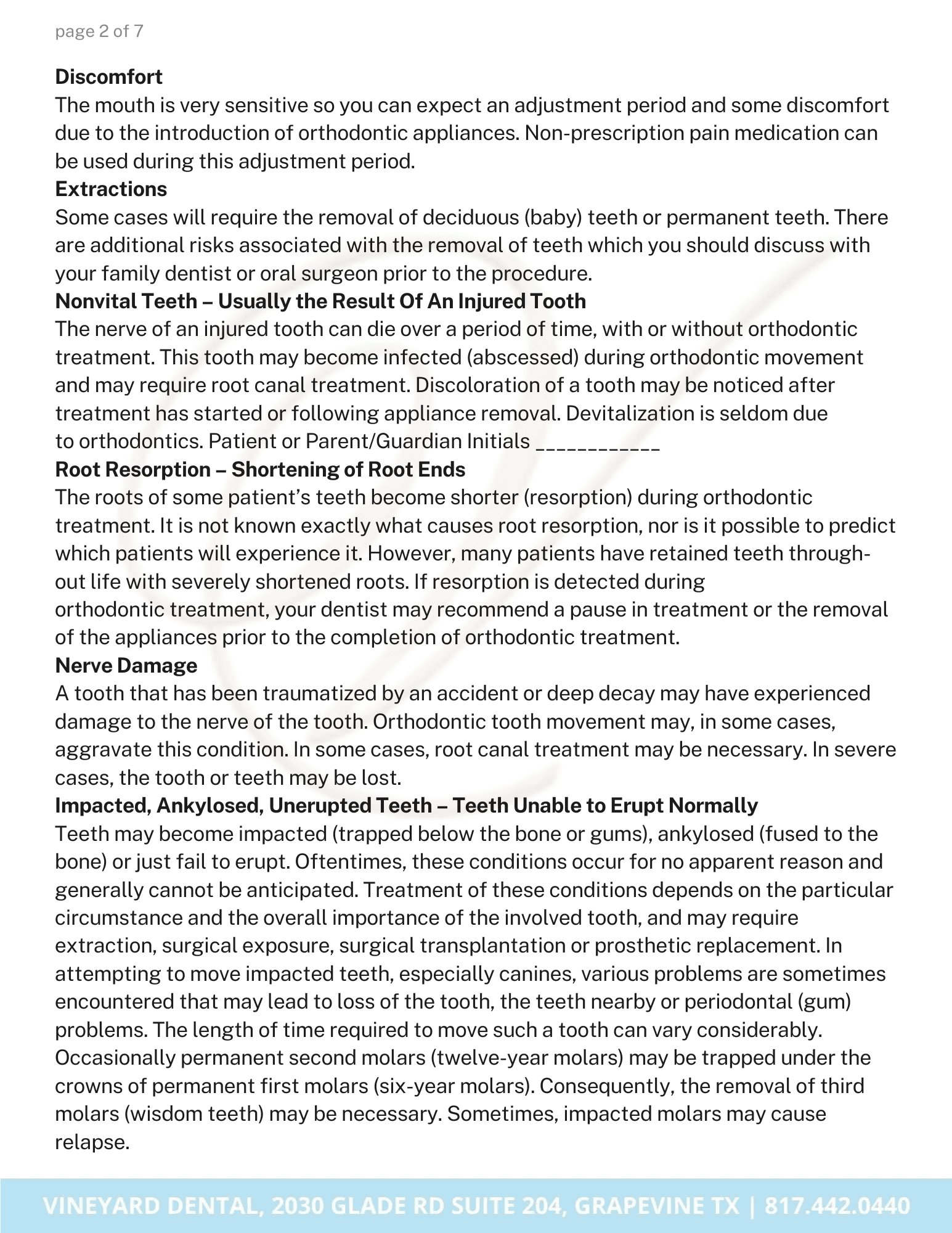
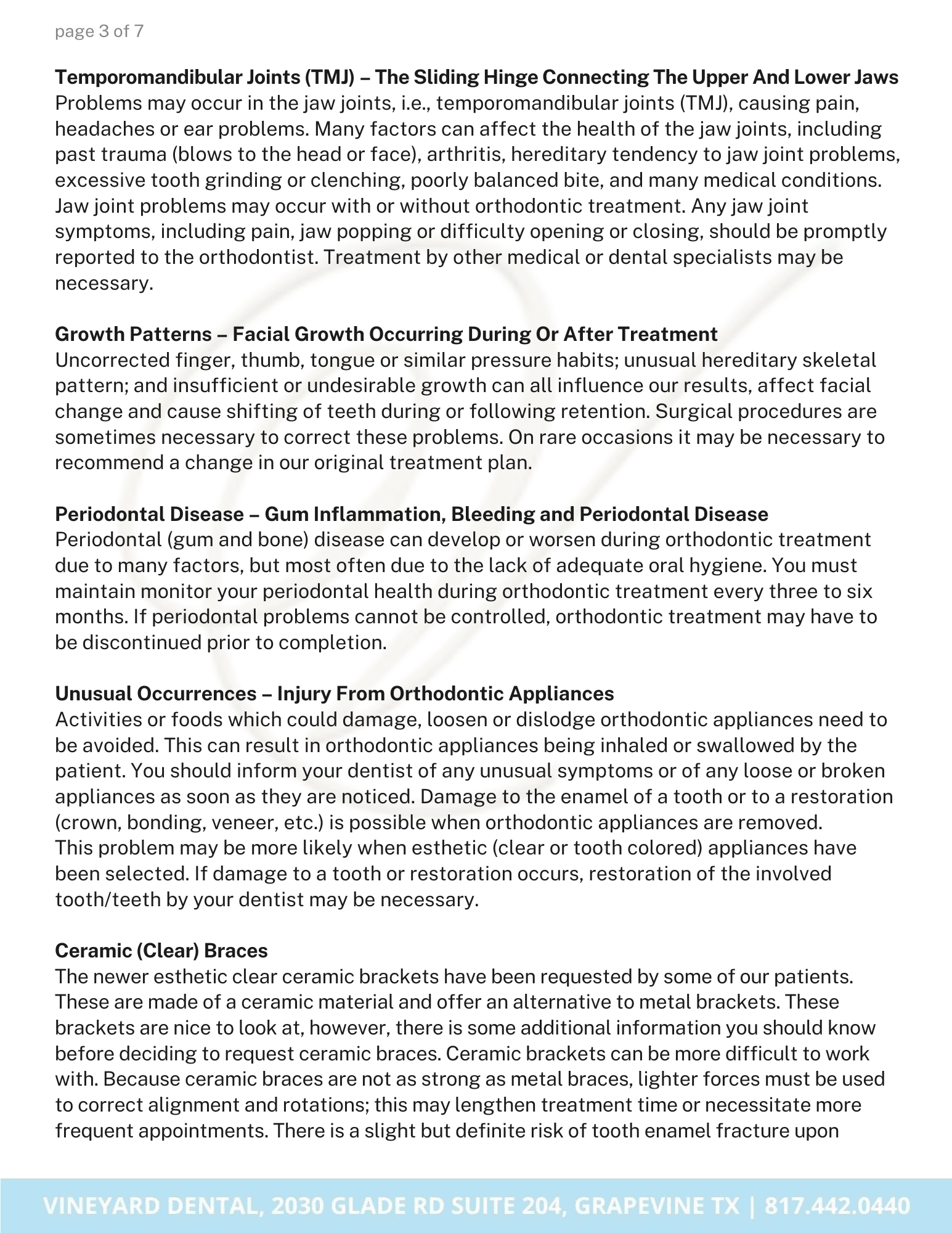
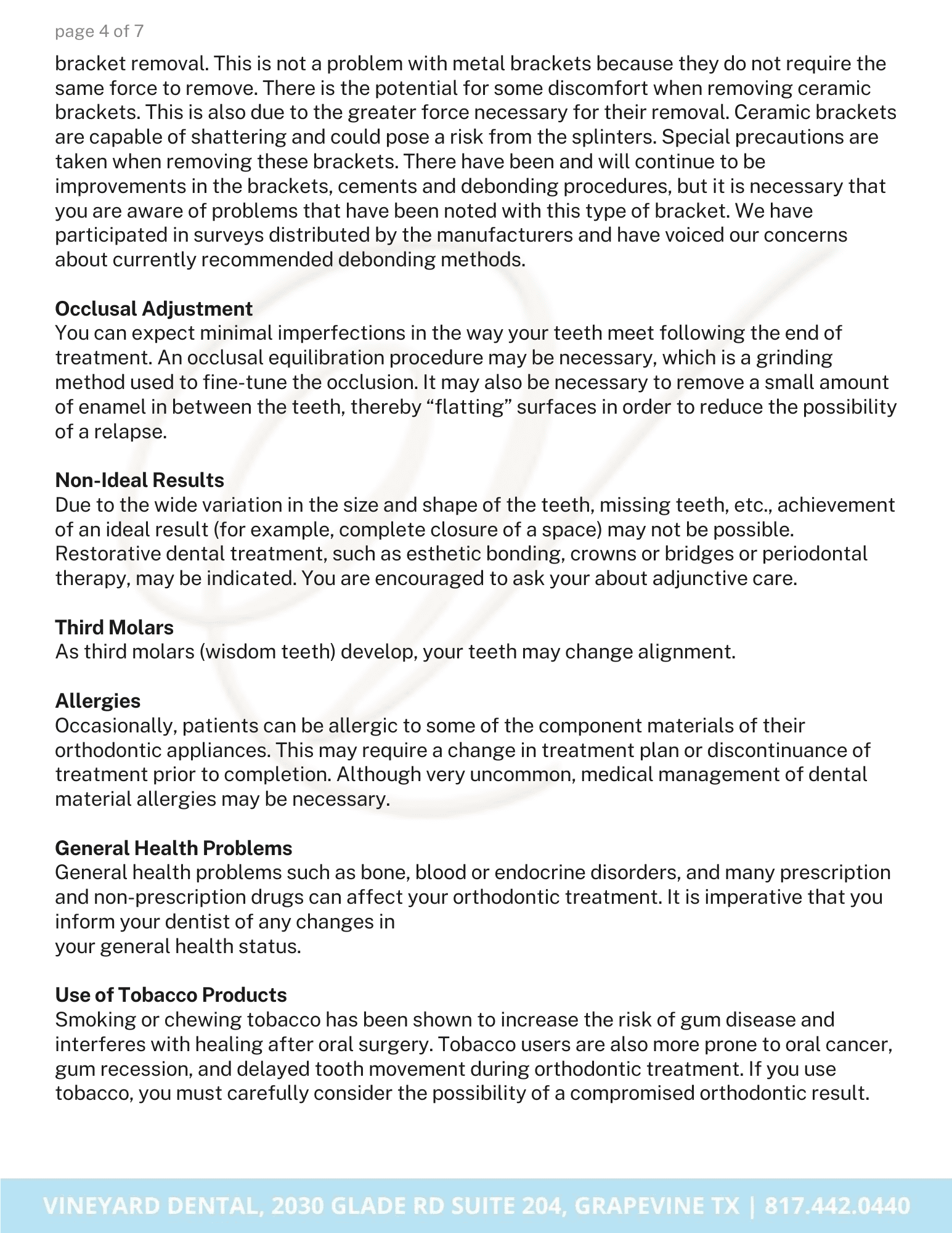
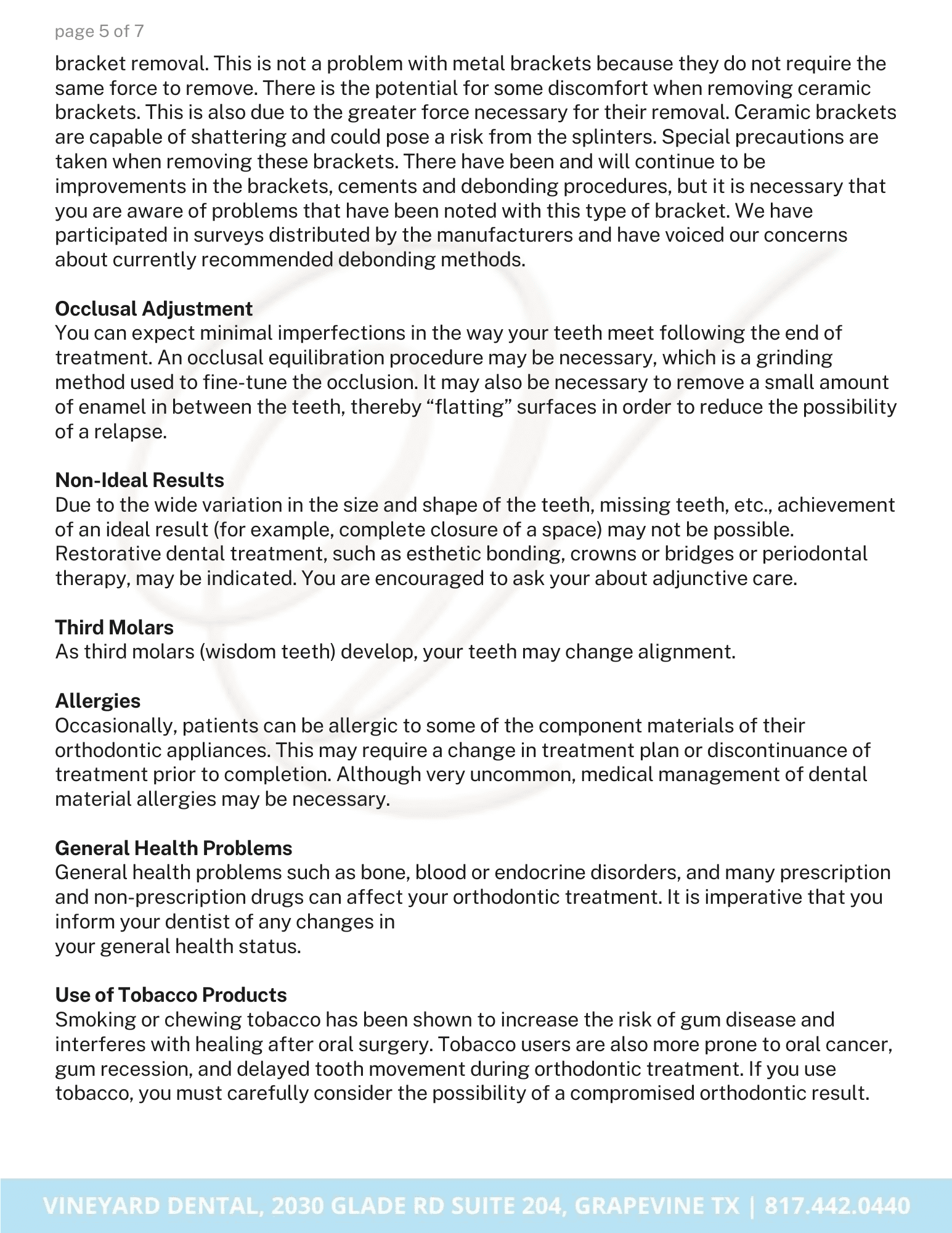
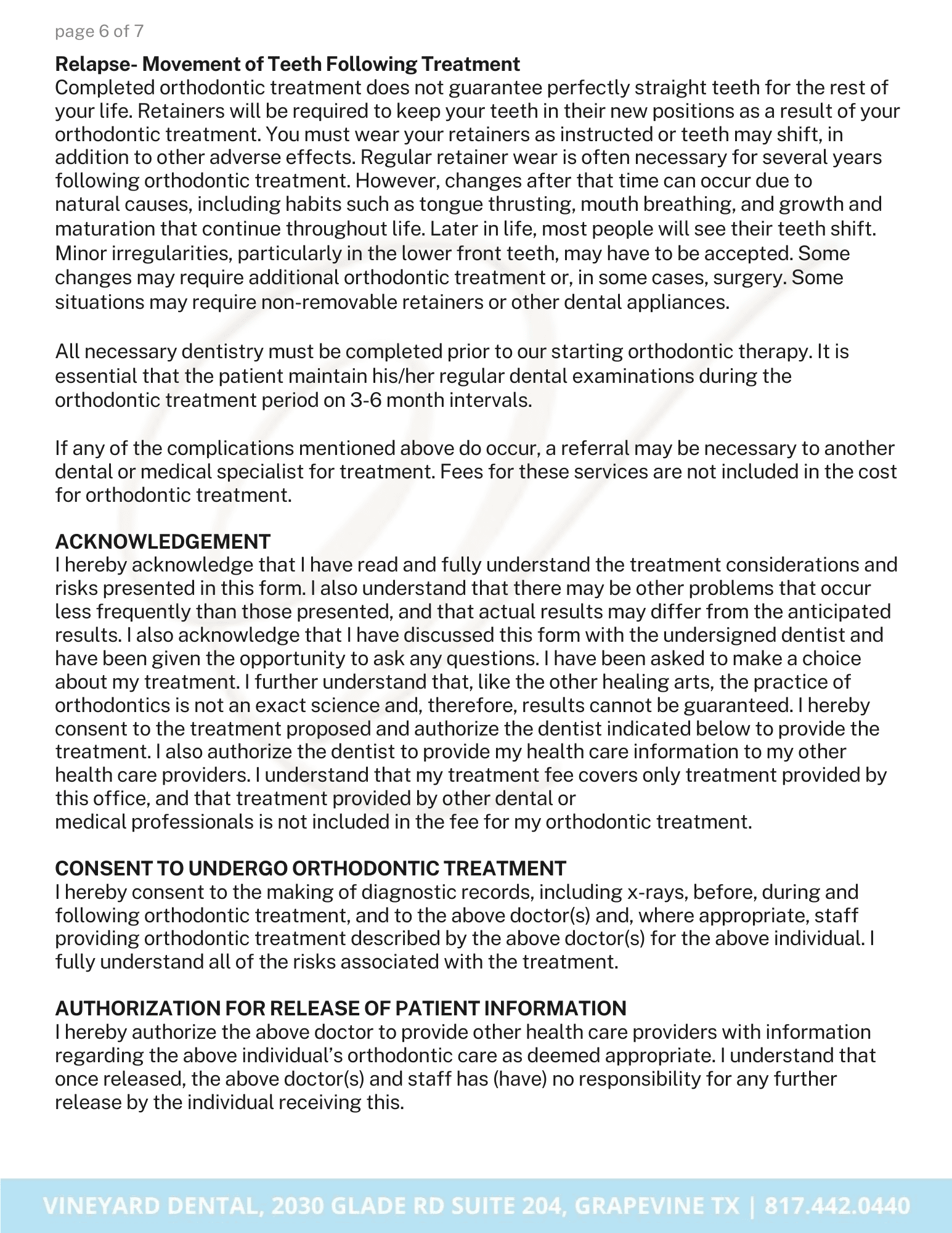
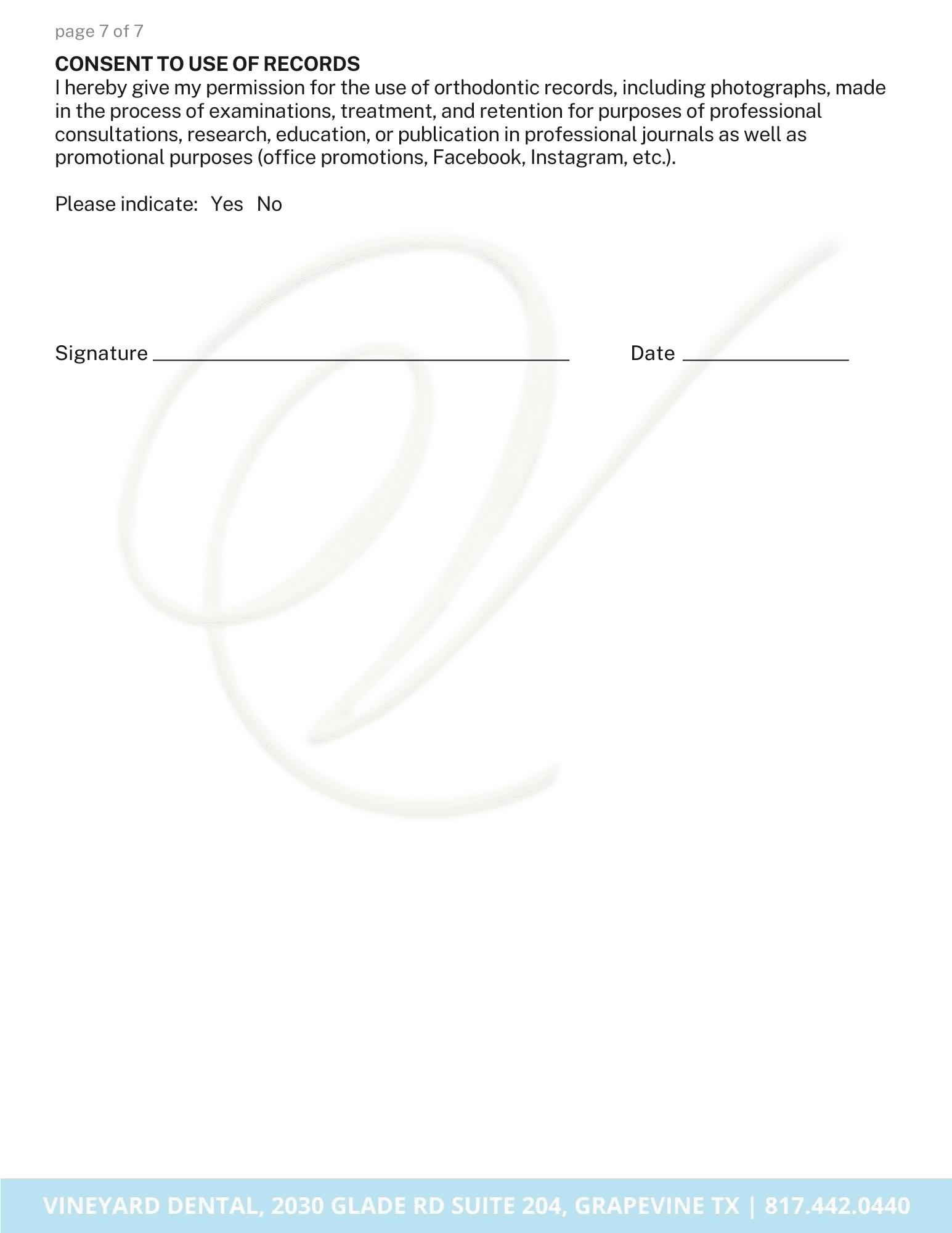
DISCOMFORT/PAIN Most patients experience slight tenderness for the first 24 hrs. The pain is similar to a sore muscle ache. Discomfort immediately after treatment is usually associated with slight throbbing or aching, and frequently is from the muscle being sore from the injection. This usually subsides in a couple of hours. Rinsing with warm salt water rinses will give some temporary relief and also aid in tissue healing. Ibuprofin or Tylenol can be taken every 4-6 hrs. for the first 24-48 hrs. to minimize discomfort.
You may eat anything you want but you may find that hard foods (like raw carrots, apples, tortilla chips) are uncomfortable. Most patients find a softer diet for the first day or two are more comfortable. Be careful to not eat anything hot (like coffee) or foods which require chewing until the anesthetic wears off. This usually takes a couple of hours.
ANY SEVERE PAIN OR SWELLING IS NOT NORMAL. If you experience any severe pain or swelling occurs, please call the office immediately.
SENSITIVITY
Some patients experience an increased sensitivity to cold, sweets or touch for the first few days. This is caused by the newly exposed root surfaces being exposed to stimuli. The symptoms can be intense the first few days but usually diminishes quickly. If the sensitivity persists, use desensitizing toothpaste like Sensodyne or Colgate Sensitive Toothpaste. If the sensitivity continues we can prescribed a stronger prescription desensitizing paste.
BLEEDING
You may notice some slight bleeding when you brush and floss the first few days but this goes away quickly as the tissues become healthier.
APPEARANCE
As the gums get healthier, the tissues seem to “shrink” and the teeth look longer or spaces appear between the teeth. This is simply the swollen tissues returning to normal. Normal healthy tissues fit the entire space between the teeth, but once bone loss has occurred, the tissues also drop away from the tooth and larger spaces appear between the teeth. These areas can be more difficult to keep clean but your hygienist can recommend how to keep these areas clean.
ORAL HYGIENE
You need to begin practicing thorough brushing and flossing TODAY. If your tissues are tender, brush gently. Brushing slower can also help. Brushing should take a minimum of 2 minutes at least once a day. Brushing several times a day with a dry toothbrush (one WITHOUT any toothpaste on it) will help remove more plaque, reduce tartar accumulation and help strengthen the gums. If you have an electric brush, you may continue to use it unless it causes too much sensitivity for the first few days. The mouth heals quickly and by the third or fourth day you should be able to resume normal daily hygiene habits. Remember that plaque is bacteria and in order for the tissues to heal you need to remove the bacteria thoroughly from all tooth surfaces. Flossing should be done once a day. Any other additional home care tools should be done as instructed by your hygienist.
SPECIAL INSTRUCTIONS
Peridex (antimicrobial rinse): Fill to “FILL” line inside cap and rinse for 30seconds once a day at bedtime. Do not rinse or eat or drink for at least 30 minutes. Some patients develop some staining on their teeth from this medication. The stains can be removed at your first maintenance appt.
Fluoridex/Prevident 5000Plus: Brush for 2 minutes, expectorate and do not rinse out. Use at bedtime. Can use as regular toothpaste if you want.
Maintenance/Reevaluation Appointment: You are to return in 4-6 weeks for your initial postop/reevaluation appointment.
This appointment is extremely critical to the success of your therapy. This appointment will not require anesthetic and should take an hour. We will check your pocket depths, bleeding sites and plaque control and determine your maintenance frequency. Any staining from the Peridex can be removed at this visit.
Whitening Steps
Floss and brush before you begin to bleach. Make sure you are well hydrated from start to finish.
When you load the tray with bleach make sure you place a tiny dot on each tooth in the tray.
When you place trays in your mouth the bleach will spread on each tooth evenly.
If any access runs out of tray onto the gums, immediately wipe off with a rag or cotton tip.
Wear trays 45 min to 1 hour
After you remove trays make sure to rinse them thoroughly and brush your teeth again.
Post-Whitening Care Instructions
Staying hydrated is imperative to the process. For the next 48 hours, dark staining substances should be avoided, such as:
- Coffee and / or Tea, Dark Sodas….if needed drink through a straw..
- Tobacco Products
- Mustard
- Ketchup
- Barbeque Sauce
- Soy Sauce
- Red /Dark sauces in general
- Red Wine
- Strawberries
- Blueberries
- Berries of any kind
- Anything Acidic
Additional ways to maintain your sparkling white smile
Avoid staining related habits
Use an automatic tooth brush
Seek regular professional dental hygiene care to maintain oral health, keep staining to a minimum and determine the need for whitening touch ups.
Practice good oral hygiene including thorough teeth brushing, flossing and removal of debris between the teeth and tongue cleaning.
HAT TO DO AFTER YOUR DENTAL IMPLANT SURGERY
WHAT TO EXPECT:
Discomfort, bleeding, bruising, and/or swelling are expected after dental implant surgery.
DISCOMFORT:
To reduce discomfort, take 2 tablets of over-the-counter Tylenol, Motrin, or Advil (avoid Aspirin) before the
numbness wears off and repeat every 6 hours as needed to control pain. If necessary, you can alternate
Tylenol and Advil every three hours as needed for pain relieve. To avoid nausea, do not take any
medications on an empty stomach. If prescribed, take any antibiotic and anti-inflammatory medication as
directed to facilitate healing. If you were given a prescription for pain medication, take it as needed for
severe discomfort only. Discontinue taking prescription pain medication after a few days or when no
longer needed for severe pain and dispose of any remaining pain medication.
BLEEDING:
Some blood will stain your saliva. This is normal. Oozing may be controlled with ice water held (not
rinsed) over the surgical site for a few minutes. Avoid strenuous activity and rest upright in a chair to
minimize bleeding. If bleeding is continuous, place a folded gauze pad or a moistened tea bag on the
tongue side of the surgical site and a second one on the cheek side and apply firm pressure with your
thumb and index finger for 20 minutes. Repeat as needed. If bleeding persists, call our office.
SWELLING:
Some swelling is expected and will be greatest for the first 48 to 72 hours following surgery. To minimize
swelling, place an ice bag on the side of your face, 15 minutes on and 15 minutes off for the first six hours
after surgery. If needed, you may continue ice compresses up to 48 hours. If possible, elevated headrest
(extra pillow) should be used during the first two nights after surgery. If steroid medication is prescribed,
take it as directed. It’s very important to finish the prescription as per instructions.
DIET:
For the first 24 hours, you should only take fluids or soft foods. Avoid any hot food. Good suggestions are
eggs, ice-cream, yogurts, cool soups and pasta. Drink at least 8 large glasses of water or juice per day for
the first few days. Orange or tomato juices are excellent following surgery as Vitamin C aids in healing.
Be sure to stick to a nutritious diet during the healing period. Studies show that people who consume well
balanced meals are less stressed and therefore less susceptible to pain. Avoid smoking and alcohol.
ORAL HYGIENE:
Keep your teeth as clean as possible. At first, only brush the teeth in the treated area gently but maintain
regular brushing routine in other areas of the mouth. The next day, you may start using warm salt-water
rinses (1 teaspoon of salt per 8 oz glass water) approximately 3 times a day or after every meal. Continue
salt-water rinses for one week or until fully healed. Prescription rinse may be given to aid in healing.
ACTIVITY:
Relax for the rest of the day and avoid any significant physical activity and exercise for the first 48 hours.
IF YOU HAVE ANY QUESTIONS OR EXPERIENCE A PROBLEM, PLEASE CALL US AS SOON AS POSSIBLE.
Bone Grafting Consent Form:

Laser Consent Form:

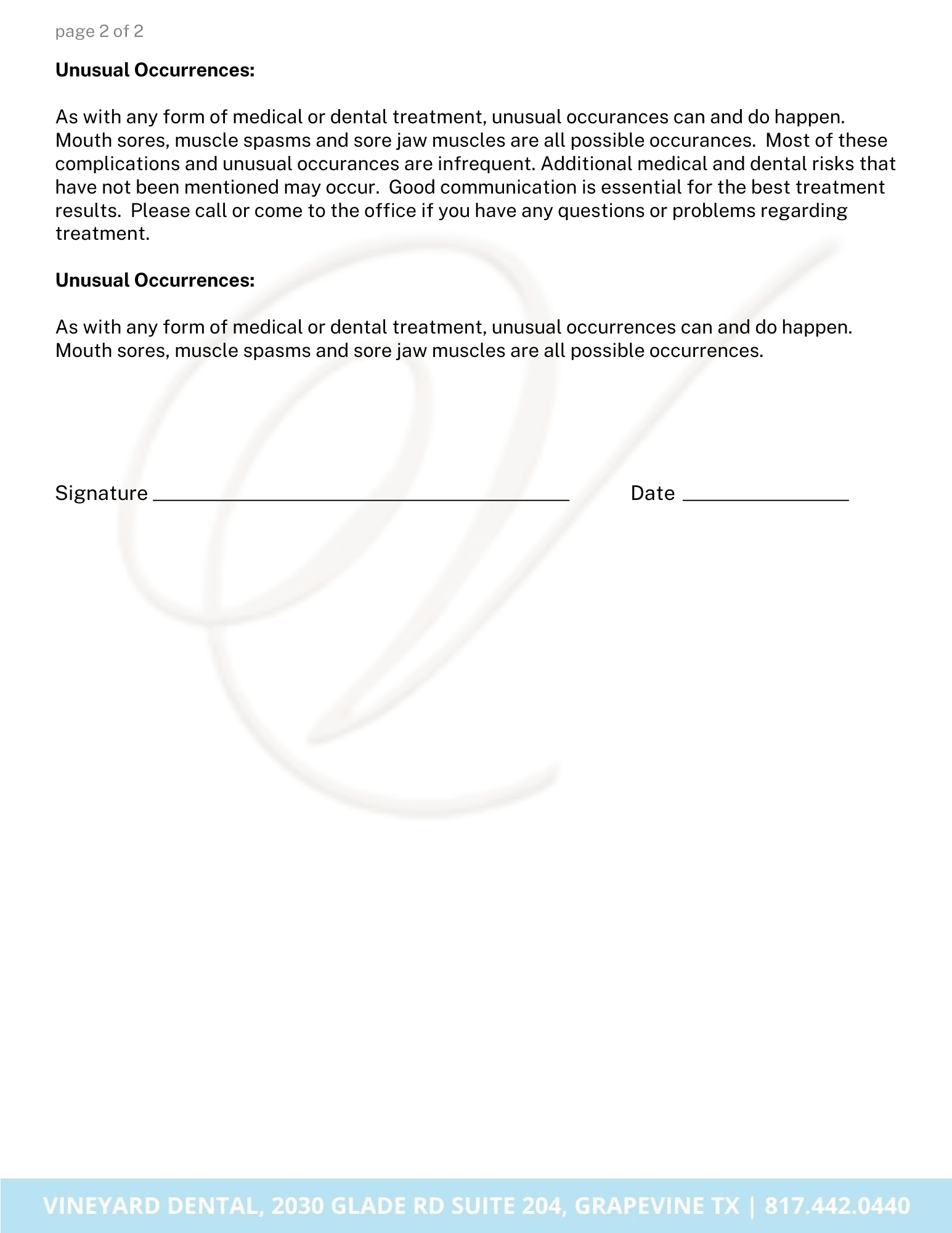
Botox Consent Form:

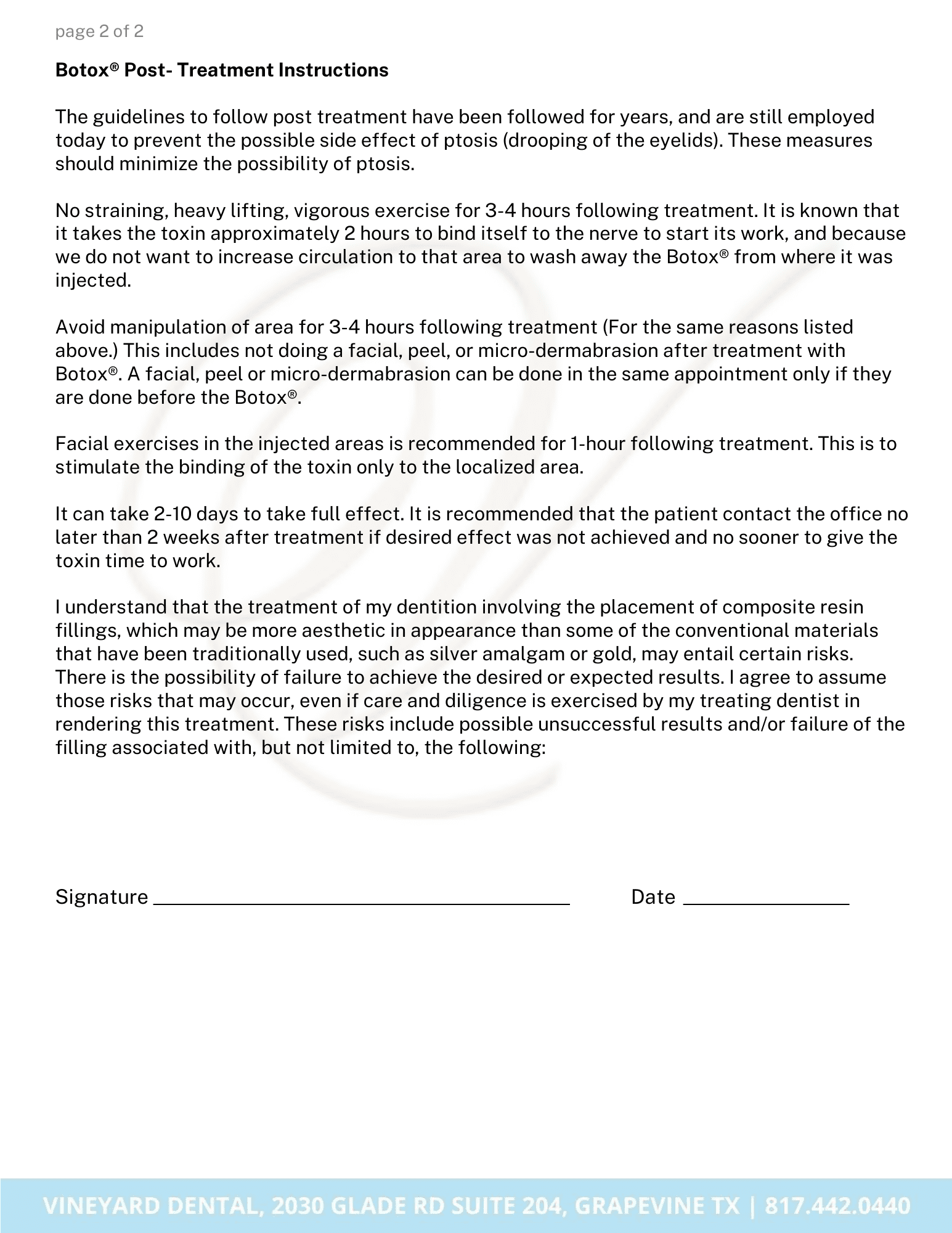
Composite or Tooth Colored Fillings Post-Operative Instructions
Once we have restored your teeth with tooth-colored materials, these restorations will serve you well for several years. The resin (plastic) material used contains small “filler” particles of glass-like material for strength and wear resistance. They contain the finest and most up-to-date materials available today.
However, you should be aware of the following information about your new restorations:
- As with natural teeth, avoid chewing excessively hard foods on the filled teeth (hard candy, ice, raw carrots, etc.) because the resin material can break under extreme forces.
- Composite fillings set up hard right away. There is no waiting time to eat. You should avoid hot foods and chewing until the anesthetic wears off. Due to the strange feeling of the anesthetic, you may accidently chew the inside of your lips, cheeks, or tongue which can cause serious damage.
- The gum tissue could have been irritated during the procedure and may be sore for a few days together with the anesthetic injection site.
- The finished restoration may be contoured slightly different and have a different texture than the original tooth. Your tongue usually magnifies this small difference, but you will become accustomed to this in a few days.
When a tooth has a cavity the Dentist removes the decay and fills the hole with a filling material, the tooth supports the filling. The ideal filling is no more than 50% of the tooth. This leaves half the tooth to support the filling. When you get a cavity that takes up 60%or more of the tooth, a crown is indicated. A crown covers the entire tooth and holds the tooth together. If breakage of this tooth or filling may happen or new decay becomes present a crown may be indicated for future treatment of this tooth.
CBCT Scan Consent Form:

Oral Sedation (Halcion) Consent Form:

Extraction Consent Form:

Root Canal Consent Forms:

Night Guards/Splints/Occlusal Guards Consent Forms:


